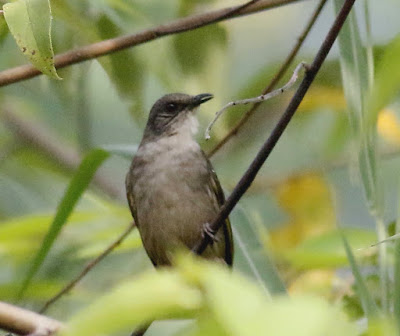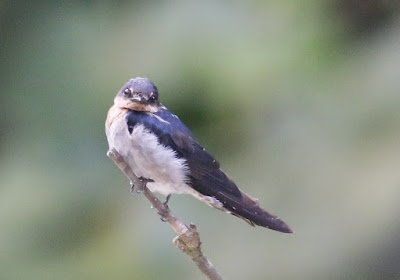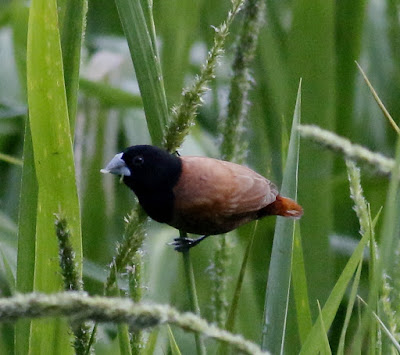Nowadays going into the social media is like walking across a minefield. You will never know what you might step on. However there is nothing better than spending a day in the forest. The day over here started with a pair of Great Slaty Woodpecker (M.pulverulentus). The pair flew towards me from the direction of Lancang and as they came closer i could hear one of the pair calling as if saying that they have finally reached their destination. Fortunately and to my delight they decided to land on a huge tree just opposite of the road where i stood.
This is my lifer for this year.
Male (left) and female (right).
While some of us would probably be seeping some nice warm tea at 8.00am, these woodpeckers have already started to work by then - attending to their unfinished nest holes.
There are three nest holes as you can see here and it certainly take some great effort from a mighty great woodpecker to excavate such huge holes on a tree.
Going further in i finally saw the 'transformation' that this place has experienced. Since "Science" is about exploring and discovering new things and not creating stuff which can destroy humankind for one's own vested interest, i decided to explore some of the trails which i could enter from the gaps in between the fences.
This was one of the trails which i have entered. While it was good to have a two fencing reinforcement strategy but i hope that the authorities, in this case probably the "Perhilitan" people are aware that some of the fences were erected on slopes which can be prone to landslides and they are also subjected to corrosion over the years. As you know "Pak Belang" can just be as smart as some domestic cats. Certainly there are lots of surveillance and maintenance work to be done here.
In ancient times, the samurai warriors were trained to access all aspects of their enemies, from their legs and hand movements to their facial expressions. Similar observations can be made in the antics of the 21st century boardroom meetings. If the Chairman or President accidentally drops his pen, the board members will be interpreting among themselves on the meaning of that incident - no bonus for this year? Then when he coughed once or twice, does he meant yes or no? Should he accidentally gassed the room, his secretary would probably be the first one to excuse herself while the jokers would try to analyse whether it came from the mutton curry or the curry fish head he ate. The same principles taught by our ancient martial arts can be applied while you explore the jungle trails especially those which are new and unfamiliar to you unless you are going for a suicide mission. Hence "staying alert" and "be aware of your surroundings" are the two essential aspects that you should take note before entering the trails.
Besides the birds, here are some of the interesting things that i have found from the trails.
This print could have been made by a deer or a boar.
This one above most likely came from an elephant - perhaps a juvenile (Yana Kuti !)
Another elephant foot print. Looks like a big one !
Now how about this one? I believe it came from a small cat - leopard ? Notice the small print just right above the cat's print ! The predator is following right beside you!
Another profile of prints - predator and victims all in one. Most of the prints were fresh - meaning the animals could have just passed thru these trails the night before or just a few hours before i came. Once "pak belang" is inside the enclosure you will probably see a different set of prints - yikes !
NOTE: DO NOT ATTEMPT TO VENTURE INTO A JUNGLE TRAIL ALONE IF YOU ARE NOT FAMILIAR WITH THE AREA!
 |
| Stripped-throated Bulbul |
From my archive i have recently managed to retrieve a local research paper written by Hossein V. Moradi and Mohamed Zakaria (MNJ, 2009) which reported that insectivores are particularly prone to forest fragmentation and habitat destruction. The forest edge specialist such as Stripped Tit babbler, Fluffy-backed babbler and common tailor bird have shown highest density close to the forest edge. While its still early to ascertain the effect of this fence project on the forest edge inhabitants here but it is apparent that some of them especially the bottom dwellers like Pittas, Great Argus and Asian Red Junglefowl were noticeably missing this time. Same goes with the Stripped Tit babbler, Rufous-crowned babbler and trogons. Sooty-capped babblers can still be heard but they too have moved further into the interior of the forest.
The early drongo catches the caterpillar ! This is a Lesser Racket-Tailed Drongo.
I realised that it is not so easy to take good photos in the forest. You either need some fast lenses or a tripod. If you have neither then you will just need to make do with what you have and try to get the best out from your equipment.
Looks like Taylor Swift has also visited this place ! Nah this was a Whiskered treeswift.
Chestnut-rumped babbler
I have also heard a Black-capped babbler and a Chestnut-winged babbler calling near the road side. They were the only babblers heard and seen during my visit.
 |
| Red-billed Malkoha |
Although i have not seen the Chestnut-breasted Malkoha for quite awhile, i was glad to see this malkoha again.
This time i saw a flock of 6 Black Hornbills hanging around at their favourite tree. This was the alpha male which was seen disturbing the other males and the two female hornbills.
This was one of the female Black Hornbill.
(note: photos have shown that female black hornbills do have broad white long supercilium too. This means that both sexes actually do have white supercilium which was previously only associated with males of this species).
The best time to see this hornbill is in the early morning (about 7.30am to 9.30am) after which they will dispersed deeper into the forest.
In addition to the occasional calls from White-rumped Sharma, the Common Hill Myna's calls were the most often heard.
 |
| Blyth's Paradise Flycatcher |
Wonder why don't they call it a Ron's Paradise Flycatcher?
 |
| Olive-winged Bulbul |
 |
| Black-bellied Malkoha |
 |
| Plaintive Cuckoo (female) |
Beside Black-bellied Malkoha, Plaintive cuckoo is reported to be a forest edge specialist too. This lone cuckoo was spotted near the vicinity of some Black-and-Yellow Broadbills.
 |
| Black-and-Yellow Broadbill (male) |
By 11.30am i was actually done with this place and from the looks of things it will certainly take awhile before this place reclaims its past glory and fame.
Until then Happy Birding!










































































